Scrapy命令行详解
官方文档:https://doc.scrapy.org/en/latest/
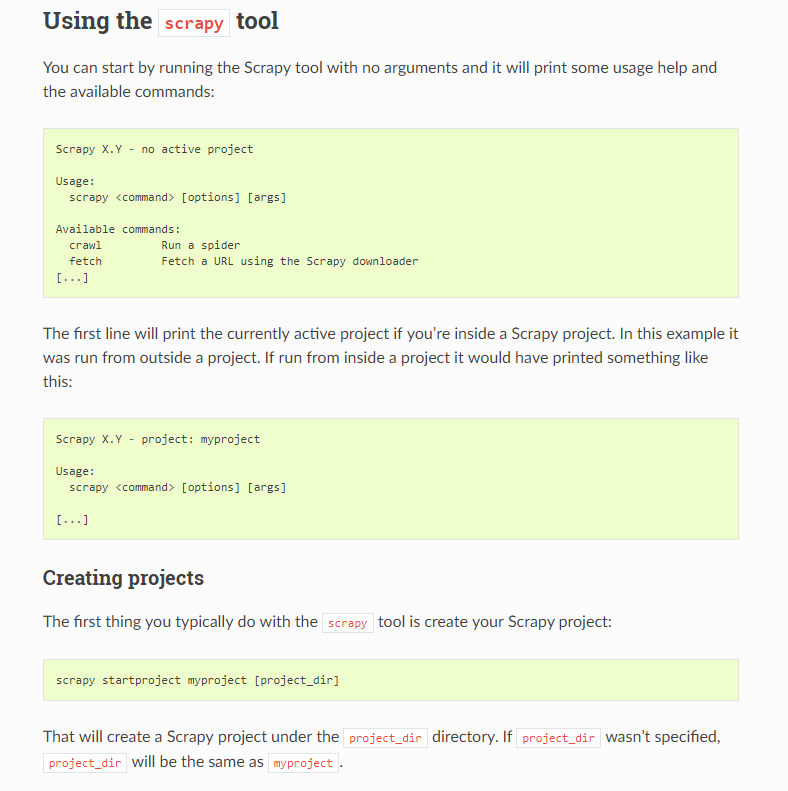
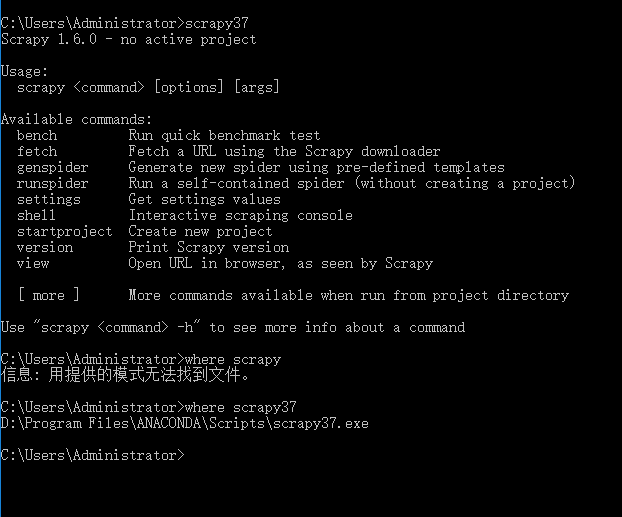
Global commands:
Project-only commands: 在项目目录下才可以执行
startproject
- Syntax:
scrapy startproject <project_name> [project_dir] - Requires project: no
Creates a new Scrapy project named project_name, under the project_dir directory. If project_dir wasn’t specified, project_dirwill be the same as project_name.
Usage example:
$ scrapy startproject myproject
genspider
- Syntax:
scrapy genspider [-t template] <name> <domain> - Requires project: no
Create a new spider in the current folder or in the current project’s spiders folder, if called from inside a project. The <name> parameter is set as the spider’s name, while <domain> is used to generate the allowed_domains and start_urls spider’s attributes.
Usage example:
$ scrapy genspider -l
Available templates:
basic
crawl
csvfeed
xmlfeed $ scrapy genspider example example.com
Created spider 'example' using template 'basic' $ scrapy genspider -t crawl scrapyorg scrapy.org
Created spider 'scrapyorg' using template 'crawl'
This is just a convenience shortcut command for creating spiders based on pre-defined templates, but certainly not the only way to create spiders. You can just create the spider source code files yourself, instead of using this command.
crawl
- Syntax:
scrapy crawl <spider> - Requires project: yes
Start crawling using a spider.
Usage examples:
$ scrapy crawl myspider
[ ... myspider starts crawling ... ]
check
- Syntax:
scrapy check [-l] <spider> - Requires project: yes
Run contract checks.
Usage examples:
$ scrapy check -l
first_spider
* parse
* parse_item
second_spider
* parse
* parse_item $ scrapy check
[FAILED] first_spider:parse_item
>>> 'RetailPricex' field is missing [FAILED] first_spider:parse
>>> Returned 92 requests, expected 0..4
list
- Syntax:
scrapy list - Requires project: yes
List all available spiders in the current project. The output is one spider per line.
Usage example:
$ scrapy list
spider1
spider2
edit
- Syntax:
scrapy edit <spider> - Requires project: yes
Edit the given spider using the editor defined in the EDITORenvironment variable or (if unset) the EDITOR setting.
This command is provided only as a convenience shortcut for the most common case, the developer is of course free to choose any tool or IDE to write and debug spiders.
Usage example:
$ scrapy edit spider1
fetch
- Syntax:
scrapy fetch <url> - Requires project: no
Downloads the given URL using the Scrapy downloader and writes the contents to standard output.
The interesting thing about this command is that it fetches the page how the spider would download it. For example, if the spider has a USER_AGENT attribute which overrides the User Agent, it will use that one.
So this command can be used to “see” how your spider would fetch a certain page.
If used outside a project, no particular per-spider behaviour would be applied and it will just use the default Scrapy downloader settings.
Supported options:
--spider=SPIDER: bypass spider autodetection and force use of specific spider--headers: print the response’s HTTP headers instead of the response’s body--no-redirect: do not follow HTTP 3xx redirects (default is to follow them) #有重定向的连接时候使用这个参数
Usage examples:
$ scrapy fetch --nolog http://www.example.com/some/page.html
[ ... html content here ... ] $ scrapy fetch --nolog --headers http://www.example.com/
{'Accept-Ranges': ['bytes'],
'Age': ['1263 '],
'Connection': ['close '],
'Content-Length': ['596'],
'Content-Type': ['text/html; charset=UTF-8'],
'Date': ['Wed, 18 Aug 2010 23:59:46 GMT'],
'Etag': ['"573c1-254-48c9c87349680"'],
'Last-Modified': ['Fri, 30 Jul 2010 15:30:18 GMT'],
'Server': ['Apache/2.2.3 (CentOS)']}
view
- Syntax:
scrapy view <url> - Requires project: no
Opens the given URL in a browser, as your Scrapy spider would “see” it. Sometimes spiders see pages differently from regular users, so this can be used to check what the spider “sees” and confirm it’s what you expect.
Supported options:
--spider=SPIDER: bypass spider autodetection and force use of specific spider--no-redirect: do not follow HTTP 3xx redirects (default is to follow them)
Usage example:
$ scrapy view http://www.example.com/some/page.html
[ ... browser starts ... ]
shell
- Syntax:
scrapy shell [url] - Requires project: no
Starts the Scrapy shell for the given URL (if given) or empty if no URL is given. Also supports UNIX-style local file paths, either relative with ./ or ../ prefixes or absolute file paths. See Scrapy shell for more info.
Supported options:
--spider=SPIDER: bypass spider autodetection and force use of specific spider-c code: evaluate the code in the shell, print the result and exit--no-redirect: do not follow HTTP 3xx redirects (default is to follow them); this only affects the URL you may pass as argument on the command line; once you are inside the shell,fetch(url)will still follow HTTP redirects by default.
Usage example:
$ scrapy shell http://www.example.com/some/page.html
[ ... scrapy shell starts ... ] $ scrapy shell --nolog http://www.example.com/ -c '(response.status, response.url)'
(200, 'http://www.example.com/') # shell follows HTTP redirects by default
$ scrapy shell --nolog http://httpbin.org/redirect-to?url=http%3A%2F%2Fexample.com%2F -c '(response.status, response.url)'
(200, 'http://example.com/') # you can disable this with --no-redirect
# (only for the URL passed as command line argument)
$ scrapy shell --no-redirect --nolog http://httpbin.org/redirect-to?url=http%3A%2F%2Fexample.com%2F -c '(response.status, response.url)'
(302, 'http://httpbin.org/redirect-to?url=http%3A%2F%2Fexample.com%2F')
parse
- Syntax:
scrapy parse <url> [options] - Requires project: yes
Fetches the given URL and parses it with the spider that handles it, using the method passed with the --callback option, or parse if not given.
Supported options:
--spider=SPIDER: bypass spider autodetection and force use of specific spider--a NAME=VALUE: set spider argument (may be repeated)--callbackor-c: spider method to use as callback for parsing the response--metaor-m: additional request meta that will be passed to the callback request. This must be a valid json string. Example: –meta=’{“foo” : “bar”}’--pipelines: process items through pipelines--rulesor-r: useCrawlSpiderrules to discover the callback (i.e. spider method) to use for parsing the response--noitems: don’t show scraped items--nolinks: don’t show extracted links--nocolour: avoid using pygments to colorize the output--depthor-d: depth level for which the requests should be followed recursively (default: 1)--verboseor-v: display information for each depth level
Usage example:
$ scrapy parse http://www.example.com/ -c parse_item
[ ... scrapy log lines crawling example.com spider ... ] >>> STATUS DEPTH LEVEL 1 <<<
# Scraped Items ------------------------------------------------------------
[{'name': 'Example item',
'category': 'Furniture',
'length': '12 cm'}] # Requests -----------------------------------------------------------------
[]
settings
- Syntax:
scrapy settings [options] - Requires project: no
Get the value of a Scrapy setting.
If used inside a project it’ll show the project setting value, otherwise it’ll show the default Scrapy value for that setting.
Example usage:
$ scrapy settings --get BOT_NAME
scrapybot
$ scrapy settings --get DOWNLOAD_DELAY
0



runspider
- Syntax:
scrapy runspider <spider_file.py> - Requires project: no #全局执行
Run a spider self-contained in a Python file, without having to create a project.
Example usage:
$ scrapy runspider myspider.py
[ ... spider starts crawling ... ]

version
- Syntax:
scrapy version [-v] - Requires project: no
Prints the Scrapy version. If used with -v it also prints Python, Twisted and Platform info, which is useful for bug reports.

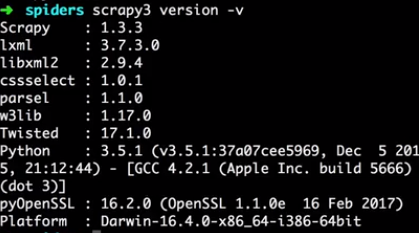
bench
New in version 0.17.
- Syntax:
scrapy bench - Requires project: no

Run a quick benchmark test. Benchmarking.
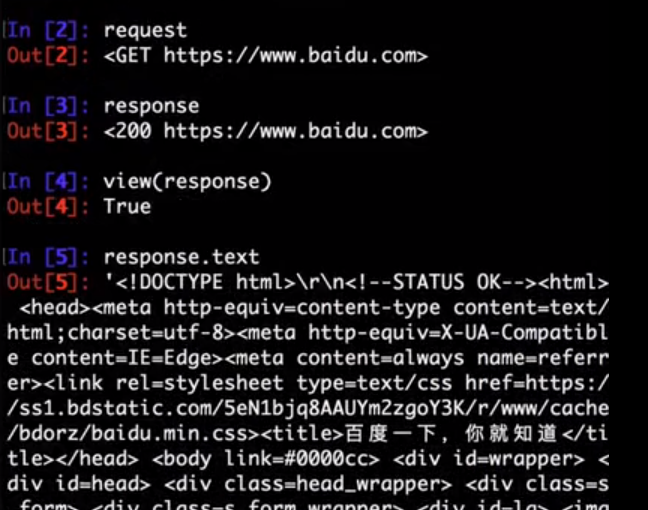
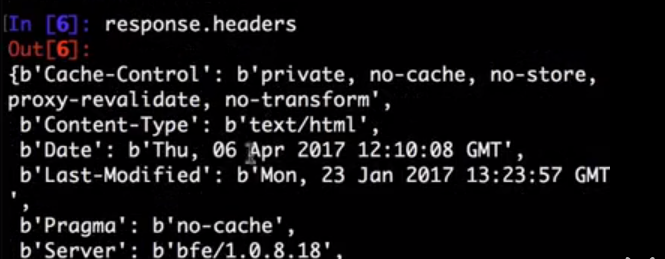

Scrapy命令行详解的更多相关文章
- 爬虫(十):scrapy命令行详解
建爬虫项目 scrapy startproject 项目名例子如下: localhost:spider zhaofan$ scrapy startproject test1 New Scrapy pr ...
- Scrapy框架的命令行详解【转】
Scrapy框架的命令行详解 请给作者点赞 --> 原文链接 这篇文章主要是对的scrapy命令行使用的一个介绍 创建爬虫项目 scrapy startproject 项目名例子如下: loca ...
- [转载]OpenSSL中文手册之命令行详解(未完待续)
声明:OpenSSL之命令行详解是根据卢队长发布在https://blog.csdn.net/as3luyuan123/article/details/16105475的系列文章整理修改而成,我自己 ...
- 7Z命令行详解
7z.exe在CMD窗口的使用说明如下: 7-Zip (A) 4.57 Copyright (c) 1999-2007 Igor Pavlov 2007-12-06 Usage: 7za <co ...
- 7-zip命令行详解
一.简介 7z,全称7-Zip, 是一款开源软件.是目前公认的压缩比例最大的压缩解压软件. 主要特征: # 全新的LZMA算法加大了7z格式的压缩比 # 支持格式: * 压缩 / 解压缩:7z, XZ ...
- Python爬虫从入门到放弃(十三)之 Scrapy框架的命令行详解
这篇文章主要是对的scrapy命令行使用的一个介绍 创建爬虫项目 scrapy startproject 项目名例子如下: localhost:spider zhaofan$ scrapy start ...
- Python之爬虫(十五) Scrapy框架的命令行详解
这篇文章主要是对的scrapy命令行使用的一个介绍 创建爬虫项目 scrapy startproject 项目名例子如下: localhost:spider zhaofan$ scrapy start ...
- gcc命令行详解
介绍] ----------------------------------------- 常见用法: GCC 选项 GCC 有超过100个的编译选项可用. 这些选项中的许多你可能永远都不会用到, 但 ...
- [转]TFS常用的命令行详解
本文转自:http://blchen.com/tfs-common-commands/ 微软的TFS和Visual Studio整合的非常好,但是在开发过程中,很多时候只用GUI图形界面就会发现一些复 ...
随机推荐
- 巧妙解决vue2.0关于set添加属性后视图不能更新的问题
今天在工作中遇到一个问题,郁闷了很久,特地写一篇博客记录一下,方便以后再遇到可以查找,也分享个各位小伙伴,在网上查找很多资料说用Vue.$set设置属性后视图也会更新,但是真相并不是这样,通过等于号赋 ...
- [JavaScript] JavaScript事件注册,事件委托,冒泡,捕获,事件流
面试题 event 事件 事件委托是什么? 如何阻止事件冒泡,阻止默认事件呢? Javascript 的事件流模型都有什么? 事件绑定和普通事件有什么区别? Event 对象 Event 对象,当事件 ...
- ioc初步理解(一) 简单实用autofac搭建mvc三层+ioc(codeFirst)
1]首先搭好框架 1.1]搭建ui层 1.2]创建其他内库文件 整个项目基本部分搭建完毕之后如下 2]使用nuget引用文件 先在每一个项目中引入ef 然后再UI层引入以下两个文件autofac和Au ...
- Android开发——使用LitePal开源数据库框架
前言:之前使用Android内置的数据库,感觉一大堆SQL语句,一不小心就错了,很难受,学习了这个LItePal的开源数据库框架,瞬间觉得Android内置的数据库简直是垃圾般的存在 LitePal ...
- JavaWeb - 模仿SpringMVC抽取 BaseServlet + 封装表单参数
模仿SpringMVC抽取一个BaseServlet,接收所有请求,然后自动封装表单参数和分发到对应的servlet执行,下面用一个页面表单提交,转发显示的项目做示例. 1)首先准备一个Entity, ...
- zepto和jQuery on事件委托在苹果手机上的”坑“
移动端用zepto做的页面,突然发现on绑定的click事件并没有触发,代码如下: <ul> <li class="a">1111111aaaaaaasss ...
- 2018 AI产业界大盘点
2018 AI产业界大盘点 大事件盘点 “ 1.24——Facebook人工智能部门负责人Yann LeCun宣布卸任 Facebook人工智能研究部门(FAIR)的负责人Yann LeCun宣布卸 ...
- 用WijmoJS搭建您的前端Web应用 —— React
前文回顾 在本系列文章中,我们已经介绍了Angular和Vue框架下 WijmoJS 的玩法. 而今天,我们将展示如何使用 WijmoJS 来搭建一款具备独特创新性.出色性能和简单代码逻辑的 Reac ...
- 解决Android Studio编译后安装apk报错:Error while Installing APK
刚开始玩 Android ,用Android studio 连接真机做测试,在虚拟机上没有问题,但是真机就会报错 检查了好多地方,最终发现了问题,网上的常规就不介绍了,大家自己去看别的帖子 手机方面 ...
- gitbook 入门教程之常用命令详解
不论是 gitbook-cli 命令行还是 gitbook editor 编辑器都离不开 gitbook 命令的操作使用,所以再次了解下常用命令. 注意 gitbook-cli 是 gitbook 的 ...
